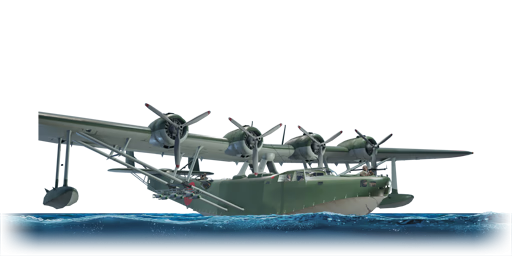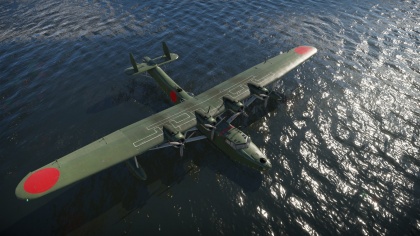H6K4
Contents
Description
The H6K4 is a rank I Japanese flying boat/heavy bomber
with a battle rating of 2.0 (AB), 1.7 (RB), and 2.3 (SB). It has been in the game since the start of the Open Beta Test prior to Update 1.27.
General info
Flight Performance
Describe how the aircraft behaves in the air. Speed, manoeuvrability, acceleration and allowable loads - these are the most important characteristics of the vehicle.
| Characteristics | |||||||
|---|---|---|---|---|---|---|---|
| Stock | |||||||
| Max Speed (km/h at 4,100 m) |
Max altitude (meters) |
Turn time (seconds) |
Rate of climb (meters/second) |
Take-off run (meters) | |||
| AB | RB | AB | RB | AB | RB | ||
| 311 | 303 | 9560 | 23.3 | 24.0 | 5.3 | 5.3 | 396 |
| Upgraded | |||||||
| Max Speed (km/h at 4,100 m) |
Max altitude (meters) |
Turn time (seconds) |
Rate of climb (meters/second) |
Take-off run (meters) | |||
| AB | RB | AB | RB | AB | RB | ||
| 341 | 325 | 9560 | 22.0 | 22.6 | 8.9 | 6.9 | 396 |
Details
| Features | ||||
|---|---|---|---|---|
| Combat flaps | Take-off flaps | Landing flaps | Air brakes | Arrestor gear |
| ✓ | ✓ | ✓ | X | X |
| Limits | ||||
|---|---|---|---|---|
| Wing-break speed (km/h) |
Gear limit (km/h) |
Combat flaps (km/h) |
Max Static G | |
| + | - | |||
| 0 | 450 | 520 | ~3 | ~2 |
| Optimal velocities | |||
|---|---|---|---|
| Ailerons (km/h) |
Rudder (km/h) |
Elevators (km/h) |
Radiator (km/h) |
| < 240 | < 240 | < 240 | > 341 |
| Compressor (RB/SB) | ||
|---|---|---|
| Setting 1 | ||
| Optimal altitude | 100% Engine power | WEP Engine power |
| 1,500 m | 1,050 hp | 1,123 hp |
Survivability and armour
Examine the survivability of the aircraft. Note how vulnerable the structure is and how secure the pilot is, whether the fuel tanks are armoured, etc. Describe the armour, if there is any, and also mention the vulnerability of other critical aircraft systems.
Armaments
Suspended armament
The H6K4 can be outfitted with the following ordnance:
- 12 x 60 kg Navy Type 97 Number 6 bombs (720 kg total)
- 2 x 250 kg Navy Type Number 25 Model 2 bombs (500 kg total)
- 2 x 250 kg Navy Type 98 Number 25 bombs (500 kg total)
- 2 x 500 kg Navy Type Number 50 Model 2 bombs (1,000 kg total)
- 2 x 800 kg Navy Type Number 80 Model 1 bombs (1,600 kg total)
- 2 x 800 kg Navy Type 99 Number 80 AP bombs (1,600 kg total)
- 2 x Type 91 Mod.2 torpedoes
- 2 x Type 91 Mod.3 torpedoes
Defensive armament
The H6K4 is defended by:
- 1 x 20 mm Type 99 Model 1 navy cannon, tail turret (432 rpg)
- 1 x 7.7 mm Type 92 navy machine gun, nose turret (582 rpg)
- 1 x 7.7 mm Type 92 navy machine gun, 2 x beam turrets (582 rpg)
- 1 x 7.7 mm Type 92 navy machine gun, dorsal turret (582 rpg)
Usage in battles
Describe the tactics of playing in an aircraft, the features of using vehicles in a team and advice on tactics. Refrain from creating a "guide" - do not impose a single point of view, but instead, give the reader food for thought. Examine the most dangerous enemies and give recommendations on fighting them. If necessary, note the specifics of the game in different modes (AB, RB, SB).
Manual Engine Control
| MEC elements | ||||||
|---|---|---|---|---|---|---|
| Mixer | Pitch | Radiator | Supercharger | Turbocharger | ||
| Oil | Water | Type | ||||
| Not controllable | Controllable Not auto controlled |
Controllable Not auto controlled |
Controllable Not auto controlled |
Separate | Not controllable 1 gear |
Not controllable |
Modules
| Tier | Flight performance | Survivability | Weaponry | ||
|---|---|---|---|---|---|
| I | Fuselage repair | Radiator | Turret 7 mm | 12 in (mod30) | |
| II | Compressor | Airframe | New 7 mm MGs (turret) | 17 3/4 in (mod45) | |
| III | Wings repair | Engine | Turret 20 mm | Improved torpedo | |
| IV | Engine injection | Cover | New 20 mm cannons (turret) | 14 in (mod35) | |
Pros and cons
Summarise and briefly evaluate the vehicle in terms of its characteristics and combat effectiveness. Mark its pros and cons in the bulleted list. Try not to use more than 6 points for each of the characteristics. Avoid using categorical definitions such as "bad", "good" and the like - use substitutions with softer forms such as "inadequate" and "effective".
Pros:
- Can carry different payloads for different targets, including torpedos
- Can land on water, thus you can capture zones with it in naval battles
- Being able to carry two 800 kg HE bombs is an effective payload capacity for Its battle rating
Cons:
- Very slow aircraft that cannot outrun any other plane really
- Defensive armaments has dead-zones which can make it difficult to engage incoming aircraft
- Slow fire rate on the turrets, Type 92 machine guns fire at 600 RPM
- The steering of the aircraft and It's overall flight characteristics is somewhat slow and clunky
History
Describe the history of the creation and combat usage of the aircraft in more detail than in the introduction. If the historical reference turns out to be too long, take it to a separate article, taking a link to the article about the vehicle and adding a block "/ History" (example: https://wiki.warthunder.com/(Vehicle-name)/History) and add a link to it here using the main template. Be sure to reference text and sources by using <ref></ref>, as well as adding them at the end of the article with <references />. This section may also include the vehicle's dev blog entry (if applicable) and the in-game encyclopedia description (under === In-game description ===, also if applicable).
In-game description
A quad-engined all-metal parasol-wing monoplane flying boat. An experimental version, the Type S, made its first flight on July 14, 1936. The plane was approved by the Imperial Japanese Navy as Type 97 Large Flying Boat in 1937. Mass production began in 1938.
The most common variant was model 22 (H6K4), created in 1940. The first 119 planes were fitted with a air-cooled 14-cylinder twin-row radial Mitsubishi Kinsei 43 engine (1000 hp). Afterwards, the slightly more powerful Kinsei 46 was used. The H6K4 carried more fuel than earlier models, increasing its maximum range to 25 hours, or 6000 kilometers. Its fuselage included waist blisters fitted with machine guns, which required a slightly longer tail section.
The H6K4 was armed with four 7.7mm Type 97 (Lewis) machine guns with 582 rounds apiece and, in the tail turret, one 20mm Type 99-I cannon with 432 rounds. The flying boat could carry twelve 60-kg bombs, four 250-kg bombs, or two 800-kg Type 91 Model 1 torpedoes.
A major weakness of all H6K flying boats was the lack of protective armor for the crew and for the fuel tanks. This was sacrificed for the sake of its extended flight range. When the plane started to suffer losses in combat, designers of later Model 22 planes began to focus on protecting the crew.
The H6K flying boat's first combat action was a raid on Wake Island on December 11, 1941. The plane was widely used in the Pacific theater during the first part of the war. The H6K ran long-range reconnaissance missions, convoy escort duty, submarine searches, bombing missions, and search and rescue operations. When the newer H8K arrived, the H6K began to be used mostly as a transport plane. The plane was in operation until the Japanese surrender in 1945.
127 H6K4s were built, out of a total of 217 H6Ks.
Media
Excellent additions to the article would be video guides, screenshots from the game, and photos.
See also
Links to the articles on the War Thunder Wiki that you think will be useful for the reader, for example:
- reference to the series of the aircraft;
- links to approximate analogues of other nations and research trees.
External links
Paste links to sources and external resources, such as:
- topic on the official game forum;
- encyclopedia page on the aircraft;
- other literature.
| Kawanishi Aircraft Company (川西航空機) | |
|---|---|
| Fighters | J6K1 |
| N1K | N1K1-Ja · N1K2-J · N1K2-Ja |
| Bombers | H6K4 · H8K2 · H8K3 |
| Hydroplane | N1K1 · E7K2 |
| Japan bombers | |
|---|---|
| Navy | |
| Carrier-based attack bomber | |
| B5N | B5N2 |
| B6N | B6N1 · B6N2 · B6N2a |
| B7A | B7A2 · B7A2 (Homare 23) |
| Carrier-based dive bomber | |
| D3A | D3A1 |
| D4Y | D4Y1 · D4Y2 · D4Y3 Ko |
| Shipboard Observation seaplane | |
| F1M | F1M2 |
| Land-based Attack bomber | |
| G4M | G4M1 |
| G5N | G5N1 |
| G8N | G8N1 |
| Flying boat | |
| H6K | H6K4 |
| H8K | H8K2 · H8K3 |
| Land-based Bomber | |
| P1Y | P1Y1 |
| Army | |
| Light | Ki-32 |
| Ki-48-II otsu | |
| Heavy | Ki-21-Ia · Ki-21-I hei |
| Ki-49-I · Ki-49-IIa · Ki-49-IIb · Ki-49-IIb/L | |
| Ki-67-I Ko · Ki-67-I otsu | |
| Other countries | ▅B-17E |





